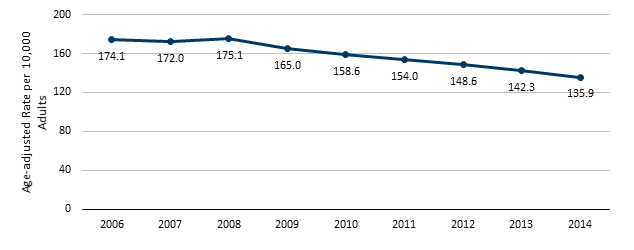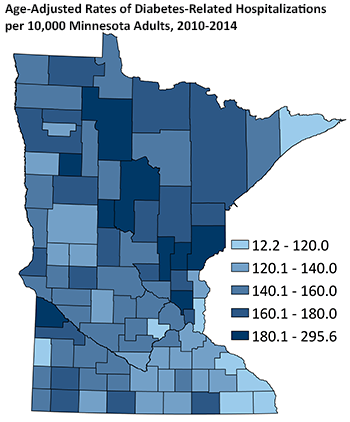Diabetes Hospitalizations in Minnesota, 2006-2014
Diabetes in Minnesota
The number of adults in Minnesota who have diabetes - type 1 or type 2 - is at an all-time high. National numbers suggest the number of new cases that develop each year may be slowing down, but we don’t have all of the information to say for sure. More than one of every five dollars spent on health care in the U.S. is to care for people who have diabetes and, in 2012 in Minnesota, at least $2.3 billion was spent on medical care related to diabetes.
Hospital rates going down
While these numbers still convey concern about diabetes in Minnesota, this report focuses on one of the bright spots – hospitalization rates for diabetes in Minnesota have been going down.
Read the full report: Diabetes Hospitalizations in Minnesota, 2006-2014 (PDF).
This is good news for Minnesota because the cost of hospitalizations among patients with diabetes is the biggest component of health care costs linked to diabetes. Nationally, inpatient hospitalizations, or admissions to the hospital, make up more than 40% of the health care costs related to diabetes.
Lower overall rates of diabetes-related hospitalizations might result from improvements in the care of people who have diabetes. That includes the care people receive from their health care provider, care and support they receive from their community, and care that people who have diabetes give themselves.
Age-adjusted rate of adult diabetes-related hospitalizations (type 1 or type 2) per 10,000 Minnesota adults, 2006-2014

Not all rates are low
 There are still large differences in rates depending on where people live within the state. Counties with populations that have higher percentages of American Indians, people who have low-incomes, and those who have lower educational attainment tend to have higher rates of diabetes-related hospitalizations. We also saw higher hospitalization rates in counties where performance on the D5 diabetes care goals or measures was lower and access to primary care was limited.
There are still large differences in rates depending on where people live within the state. Counties with populations that have higher percentages of American Indians, people who have low-incomes, and those who have lower educational attainment tend to have higher rates of diabetes-related hospitalizations. We also saw higher hospitalization rates in counties where performance on the D5 diabetes care goals or measures was lower and access to primary care was limited.
This information can help us identify the specific areas of the state where diabetes related hospitalizations are higher so that we can dig deeper into the underlying reasons behind the high rates and focus attention on the communities that need it most.
Strategies that may be affecting hospitalization rates
The Minnesota Department of Health, local public health programs, non-profit organizations and other partners are working in several arenas to address and improve diabetes management. The following strategies could be contributing to the decrease in hospitalizations over time.
In health care
- Increasing health care access by addressing provider shortages and related infrastructure problems.
- Expanding use of team-based care, which may include the use of new providers in areas with need. For example, some rural areas have used community paramedics to address previously unmet needs.
- Refining clinically-measured care goals to meet the needs of diverse communities and to better stimulate improvements in care.
In communities
- Increasing access to and promotion of diabetes self-management education and support (DSMES) classes and ongoing support for managing their diabetes.
- Reducing or eliminating the co-pays for diabetes education
- Allowing individuals to self-refer into programs
- Increasing access to culturally-tailored DSMES classes
- Using telemedicine or other alternative delivery methods for DSMES
- Ensuring reimbursement for new modes of delivery for DSMES
- Increasing the number of Living Well with Chronic Disease and Living Well with Diabetes classes that can help to support people with diabetes
- Changing the environments in which we live, work, and play to help reduce smoking, increase physical activity, and improve access to healthy foods.
For more information
Download the complete report Diabetes Hospitalization in Minnesota (2006-2014) (PDF).
If you have questions about this report, contact: Emily Styles at Emily.Styles@state.mn.us.